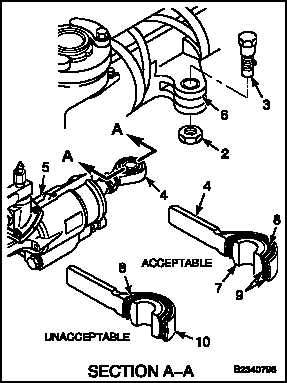TM 55-1520-240-23-4
5-87.2
INSPECT SHOCK ABSORBER WITH ELASTOMERIC BEARINGS (Continued)
5-87.2
2.
Check for oil leakage. Static leakage at any
location shall not exceed a slight wetting.
Leakage shall be less than one drop. If more,
replace shock absorber (Tasks 5-87 and 5-93).
Perform operational leakage inspection (Task
1-58).
3.
Remove nut (2) and bolt (3) securing shock
absorber (5) to bracket (6) (Task 5-87).
4.
Remove shock absorber rod end bearing (4)
from bracket (6). It may be helpful to have helper
push on trailing edge of the affected blade to
extract rod end from bracket (6).
NOTE
The elastomeric bearing is bonded
to the shock absorber outboard rod
end. If the bearing is found to be
unacceptable, replace the entire rod
end.
5.
Inspect the elastomeric rod end bearing (4) as
follows:
a.
Try to rotate ball (7) by hand. If the ball
rotates, it indicates complete unbonding.
Reject the bearing.
NOTE
If shim is covered by elastomeric
material, the bearing is acceptable.
Evidence of dust-like particles of
elastomeric material or evidence of
small particles breaking away from
the surface of the elastomeric material
are not causes for rejection.
b.
Check if shim (8) is visible. If it protrudes
above elastomeric material (9), reject the
bearing if any of the following conditions exist:
(1)
Protrusion of shim above plane of bearing
housing (10).
(2)
Unbonding of shim from elastomeric
material.
NOTE
On certain bearings, shims are
installed in two pieces. A split
between the shim halves is normal.
(3)
Broken shim. Check with a feeler gauge
or similar tool.
6.
Replace rod end if found unacceptable (Tasks
5-88 and 5-89) and adjust rod end length (Task
5-90). Go to step 8.
7.
If bearing is acceptable, reconnect rod end to
blade. Go to step 12.
Change 2
5-529

